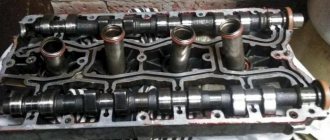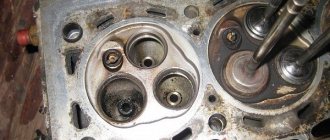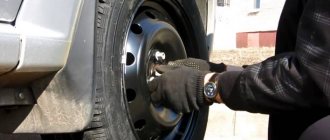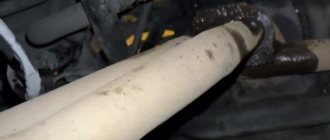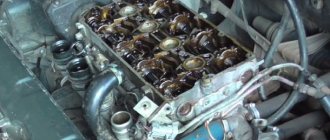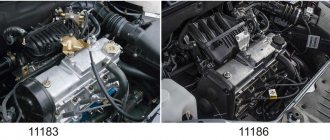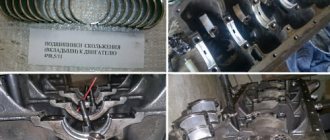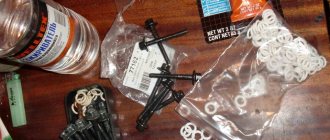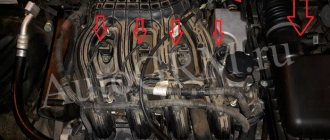The cylinder head (cylinder head) and block connector crosses the combustion chambers and cavities in which oil and coolant circulate. The importance of correct tightening of cylinder head fasteners is explained by the need to separate these working environments. The tightening torque of the cylinder head bolts holds the head, which is subject to gas pressure and thermal load. A complex part also experiences complex deformations, which forces the manufacturer to carefully develop technical conditions for tightening the cylinder head, the main of which are the tightening torque and order.
Consequences of incorrect cylinder head installation
Correct tightening of the cylinder head is very important, since the performance of the motor directly depends on it. The cylinder head acts as a cylinder cover, and any violations in its fit affect the processes occurring inside the power unit.
Insufficient tightening of the head leads to a drop in compression due to loss of tightness at the junction of the cylinder head with the cylinder block, burnout of the gasket, breakthrough of working gases from the cylinders and their entry into the channels of the lubrication or cooling systems, penetration of technical fluids into the combustion chambers, which in turn is negative affects the functioning of the power unit and can cause very serious damage.
Excessive tightening also does not bring anything good; in this case, damage to the head often occurs - cracks appear, or fasteners are destroyed - bolts break, threads break, etc.
Uneven or incorrect tightening often causes warping of the head, due to which gaps appear at the junction of it with the block, which leads to the same consequences as insufficient tightening.
Basic recommendations
First of all, it should be noted that such a procedure can be carried out after repairing the power unit or in order to check the tightening torque of the bolts during engine operation. If the cylinder head has been dismantled, you should carefully inspect the bolts, as well as the holes in the cylinder block for their installation. Screws must not have elongation or deformation of the threaded part. The holes in the block for the bolts are cleaned of any remaining engine oil, liquid, or other foreign particles. If this is not done, the cylinder block may be damaged, and the cylinder head will not be able to be tightened with the required force.
Work should begin only after reading the vehicle manufacturers' recommendations for operation and repair. There the driver will find all the necessary information to complete the job, including the forces and sequence of tightening the bolts.
Important! For engines with TTY bolts, there is a prohibition on reuse, as they may break.
Another feature of using such bolts is their installation at a certain angle. To do this, you will need a special key with an indicator that will show the degree of inclination.
User Igor Ivanov shows in the video the installation and tightening of the cylinder head.
.
What errors may occur
Unfortunately, drivers who independently restore the power unit make annoying mistakes that can harm the cylinder block and the working tool.
These include the following:
- leaving motor grease or other foreign particles in places where fasteners are installed;
- overestimation of the bolt tightening force;
- using a tool not intended for this operation;
- non-compliance with the sequence of tightening the cylinder head;
- use of bolts of inappropriate length.
If the moment of tightening the motor mounting screws is determined “by eye,” most often overtightening occurs, which leads to the bolts breaking. Worn edges of the key can damage the head of the fastener, after which it will be impossible to screw it in or out. Changing the order of installing the bolts yourself will lead to overstresses in the head housing, and this can lead to the appearance of cracks. They can be through, which contributes to the appearance of lubricant or coolant leaks. A gas breakthrough will appear in the intake or exhaust manifold. Interruptions in the operation of the motor will begin and its power will be lost.
Cylinder head crack
If engine cooling fluid enters the lubrication system through cracks or burnouts, the engine oil will dilute. After this, the lubricant pressure will decrease, and its supply to the friction points will be insufficient, and the crankshaft liners may turn. Many documents allow the reuse of fasteners, but it is better to use new products. The cylinder head should be attached to the cylinder block only with high-quality screws.
Part Features
The cylinder head is a structurally quite complex part. It is a massive plate in which there are channels for the circulation of fluids of the lubrication and cooling system, and technological holes - spark plugs, for injectors (in diesel engines), mounting holes.
Also on top of the cylinder head there is a so-called “bed” of the camshaft - a seat for its installation.
Despite its massiveness, the block head is a fragile part due to the voids inside, so excessive tightening force often leads to cracks in the walls and bridges.
For the manufacture of cylinder head, two types of metals are used - aluminum (the most common) and cast iron.
To secure the latter, steel bolts or studs with nuts are used. For example, the head of the UAZ 31519 block is secured with studs.
The difference in the materials used to make the head and its fasteners has one negative factor - different thermal expansion of the components when heated, especially for aluminum cylinder heads.
Uneven tightening of fasteners (nuts, studs, etc.) during thermal expansion leads to the appearance of excessive stress in the metal structure, resulting in warping of the head.
Bolt tightening conditions
When installing the cylinder head, it is important to comply with the tightening technology, which includes a number of criteria:
- Tightening order;
- An effort;
- Condition of fasteners (for example, studs with nuts);
Each engine has its own tightening order, which must be followed to ensure uniform tightening of the head to the block and to prevent the occurrence of stress on any surface areas. For example, on a VAZ 2105 it looks like this.
Force is another important factor for the correct fastening of this engine element. Attracting the plate is carried out in several approaches (their number differs on different motors), each of which is performed with its own force.
The cylinder head fasteners are tightened with quite a lot of force, which leads to them being pulled out. Therefore, on many engines, bolts cannot be reused; they must be replaced. But there are also motors for which replacement of fasteners is not necessary and their re-installation is possible.
All information regarding the cylinder head tightening technology is indicated in the technical specifications. documentation for the car, it is also often indicated on the packaging of head gaskets and fasteners.
How to remove a cylinder head bolt with torn edges from a cylinder block
First you need to try to unscrew the bolt without using a cutting tool. Chips and metal dust, not to mention abrasives, getting into the engine do not bode well:
- The bolt head must be tapped in the axial direction through the brass spacer. This will significantly weaken the strength of the connection.
- Try to drive inside or outside the bolt head with a suitable tool. Inch, metric - it doesn't matter. If only he could hold on. Unscrew.
- There is such a tool - a nut cutter. A ring into which the cutting tooth extends. If the dimensions allow, place it on the head of the bolt, press the tooth and try to unscrew it.
- You can weld a new nut.
- If you have the skill, use a chisel. First, use a sharp chisel to penetrate the head of the fastener. Now place a blunt tool on this ledge and sharply hit it to unscrew it. The method requires skill, but it is very effective.
If the previous options do not work, use a hand saw or grinder to cut the slot and cut off the head (be careful not to damage the seating surface). Loosen the remaining bolts and remove the cylinder head. The fragment sticks out high - everything is in your hands. Hairpin guns, Swedes, crocodiles are quite suitable.
If you had to drill, then after passing the hole with a drill, use an extruder - this is a conical tool with a left-hand thread and a steep rise in the turns, which resembles a gimlet. Introduced into drilling, it rigidly clings to the walls with its working edges. Rotate it counterclockwise along with the stuck hardware. The extruder is much more efficient than a triangular file driven inside.
Before drilling, protect the motor from chips.
General rules for performing work, methods used
There are a number of general rules that must be followed when installing the block head:
- It is important to strictly observe the tightening torque. For these purposes, a special tool is used - a torque wrench. It is not recommended to perform this operation with regular keys;
- The head bolts must be pulled smoothly, jerking is not allowed. Since the tightening force on the last approaches is significant, extending the wrench arm with a pipe can simplify the procedure and ensure smooth, uniform tightening;
- Before installing the bolts, you need to carefully inspect the condition of the threads on them. There should be no dirt or foreign particles on the coils.
- The threads of fasteners should be lubricated with engine oil before tightening. But you should not pour grease into the holes for the bolts (especially for “blind” holes), since in the future it will not allow the fasteners to be fully tightened.
Despite the fact that each engine has its own characteristics of tightening the cylinder head, the general technology of this operation is the same. In general, two methods are used to tighten fasteners:
- In several approaches, bringing the tightening force to the required value;
- Tightening the fasteners to a certain force (in one or more approaches), and then tightening the bolts twice to a certain angle.
The tightening method is selected based on the type of bolts.
The first method is used when using non-stretching bolts (these are not used now, but they can be found on old cars). But often this type of fasteners requires tightening after a certain period of engine operation in order to compensate for the shrinkage of the cylinder head gasket. But such fasteners are allowed for reuse, and more than once.
The second method of tightening the block is relevant for most modern cars. And all due to the use of tensile bolts (the so-called TTY type).
Such fasteners, due to elastic deformation, are able to compensate for thermal expansion of the head and shrinkage of the gasket, but for this they need to be put into deformation mode (in fact, just stretched a little).
To do this, it is necessary to tighten the bolts twice to a certain angle. On some cars this angle is 45 degrees, on others it is 90 degrees.
But after the elements are put into elastic deformation mode, they will no longer be able to return to their original state, and therefore their reuse is not allowed due to the high probability of destruction.
Tools used
Manufacturers offer various types of wrenches that help limit the tightening force of threaded connections. The three most common types of torque wrenches are:
- click (mechanical);
- pointers (analog);
- electronic (digital).
Motorists select models that have optimal characteristics. Sometimes, advice from friends or articles on the Internet help you make the right choice.
Snap
The key got its name due to the specific sound it makes. This ratchet is in demand in small auto repair shops or among drivers who prefer to carry out repairs themselves.
Positive characteristics are affordable cost and acceptable torque error of 5%. In online stores, the device has a price of 2–2.5 thousand rubles. Popular models are Arsenal and Berger.
General procedure
Although tightening the cylinder head has many nuances and features, the general technology of the operation is not complicated, it is only important to comply with the conditions.
The general algorithm of work is as follows:
- We study the documentation (tightening order and force);
- We prepare the tool;
- We inspect and wipe the surfaces of the block and head, clean the mounting holes (with a rag or compressed air);
- We lay the gasket;
- We put the block head in place (the correct placement of the gasket and head is ensured by guide bushings);
- Lubricate the threads of the fasteners;
- We install the latter in the holes and tighten them by hand;
- We specify the drawing scheme, the number of approaches and the force of each of them, as well as the time of breaks between approaches (all this is indicated in the documentation);
- We make the first approach, observing the tightening order (for convenience, you can mark the bolts according to the order with a marker). In the photo is a VAZ 2103;
- We carry out all subsequent approaches.
Some vehicles additionally require re-tightening of fasteners after a certain period of vehicle operation. This information must be indicated in the technical documentation.
Some nuances
The tightening torque is one of the main factors for the normal fit of the block head. But this criterion is influenced not only by the applied force, but also by the fasteners themselves:
- General condition of the bolts – new or used;
- Presence of lubricant on the threaded part;
- Thread condition.
The type of power plant (petrol, diesel), as well as the number of valves, does not affect the cylinder head tightening technology. But this does not mean that the force and tightening procedure are identical for all motors, and before seating the head, you should definitely study the conditions for performing the operation and all its features.
Regular keys
Some sources recommend tightening the bolts until yield begins. I am not a supporter of this method. With ordinary wrenches you can easily feel this very fluidity of the bolt (you do not increase the force, but the bolt head continues to rotate due to deformation). I will try to list the advantages and disadvantages of the method:
+ Available. Everyone can find open-end wrenches, ring wrenches, or a set of sockets with a wrench.
+ No special skills required.
— At the first stages of broaching, it is not possible to ensure uniform force on the bolts.
— You can break the thread or bolt. Trying to determine the onset of yield of a material is a dubious endeavor.
Common Mistakes
Despite the fact that automakers clearly indicate the procedure and nuances of tightening the cylinder head, many car enthusiasts make mistakes when assembling the engine. The most common of them are:
- Pouring oil into the mounting holes to lubricate the threads (the liquid is incompressible, so poured oil will not allow the head to be properly tightened);
- Over-tightening (exceeding tightening forces leads to damage to the cylinder head and the fasteners themselves);
- The use of damaged or inappropriate keys (the edges of the bolt heads may be torn off, after which it will be problematic to tighten or unscrew them normally);
- Use of unsuitable bolts as replacements (fasteners from different engines may differ in length, thread spacing, head height and diameter);
To avoid problems in the future, you should use only fasteners designed for a specific engine and fully comply with the work conditions.
Video “How to use a torque wrench”
User Alexander Mart shows a video about using a torque wrench.
Do you have any questions? Specialists and readers of the AUTODVIG website will help you ask a question
Was this article helpful?
Thank you for your opinion!
The article was useful. Please share the information with your friends.
Yes (81.82%)
No (18.18%)
X
Please write what is wrong and leave recommendations on the article
Cancel reply
Rate this article: ( 11 votes, average: 4.82 out of 5)
Discuss the article:
Features of the work performed using the example of some cars
To prove the proposition that each power plant has its own characteristics of tightening the cylinder head, let’s consider the nuances of performing work on specific models.
VAZ-2112 16 valves
A number of modifications of the VAZ-2112 were equipped with two types of 16-valve power plants (factory indexes - 21120 and 21124). These two motors, despite some design features, have identical head tightening technology.
These units use 93mm long tension bolts. In this case, reuse of fasteners is allowed, but under one condition - if their length does not exceed 95 mm (if it is longer, they should be replaced). 10 bolts are used to secure the head.
Tightening is carried out in three approaches:
- The bolts are tightened according to the order with a force of 2 kg/m;
- Turning 90 degrees;
- Repeated tightening to 90 degrees.
The drawing diagram is shown below.
Between the 2nd and 3rd approaches you need to take a 20-minute break.
Since these engines use tensile bolts, additional tightening is not required during vehicle operation.
VAZ-2107
On the VAZ-2107, all installed modifications of power units are 8-valve.
The block head is attached to them with 11 bolts, 10 of which are main, and 1 is an auxiliary side bolt (installed in the side protrusion).
On this car, tightening fasteners is also performed in three approaches:
- 10 main bolts are tightened in order with a force of 3.5-4.0 kg/m;
- The same bolts reach with a torque of 11.5-12.0 kg/m;
- The auxiliary is tightened with a force of 3.5-4.0 kg/m.
Additional tightening of the cylinder head is not required when operating the VAZ-2107.
"Samara", 10th family, Priora
On models of the Samara family (2108-21099), as well as VAZ 2110-2112 with 8-valve units, tightening is already performed in 4 approaches:
- Tightening with a force of 2.0 kg/m;
- Reaching with a moment of 7.5-8.5 kg/m;
- Turn 90 degrees;
- Repeated rotation by 90 degrees.
The break between points 3 and 4 is 20 minutes.
As for the VAZ of the “tenth” family, which are equipped with 16-valve engines, their tightening technology is the same as that of the VAZ-2112 (described above).
The same applies to the Lada Priora; on 8-valve units, a method with 4 approaches is used (VAZ 2108-21099), and on 16-valve units, 3 approaches are used (VAZ 2112 with a 16-valve engine).
"Volga"
On ZMZ-406 engines installed on the Volga, according to the automaker’s technical documentation, tightening the engine block head bolts is carried out in two approaches:
- With a force of 4.0-6.0 kg/m;
- With a moment of 13.0-14.5 kg/m.
But many car owners of this car note that this technology does not allow the cylinder head to be properly tightened, so they use techniques with a large number of approaches.
A common method is the cross method, performed in 4 stages and with the following efforts:
- 4.0-4.3 kg/m;
- 7.5 kg/m;
- 11.0 kg/m;
- 14.3-14.5 kg/m.
Subsequent tightening of the bolts is not required when operating on this engine.
Table 2. Tightening torques – electrolytically galvanized screw, friction coefficient 0.125.
Large carving
| Thread diameter | Strength class | |||||||
| 5.6 | 8.8 | 10.9 | 12.9 | |||||
| Nm | ft lb. | Nm | ft lb. | Nm | ft lb. | Nm | ft lb. | |
| M3 | 0.56 | 0.41 | 1.28 | 0.94 | 1.8 | 1.33 | 2.15 | 1.59 |
| M4 | 1.28 | 0.94 | 2.9 | 2.14 | 4.1 | 3.02 | 4.95 | 3.65 |
| M5 | 2.5 | 1.84 | 5.75 | 4.24 | 8.1 | 5.97 | 9.7 | 7.15 |
| M6 | 4.3 | 3.1 | 9.9 | 7.3 | 14 | 10.3 | 16.5 | 12.1 |
| M7 | 7.7 | 5.2 | 16.5 | 12.1 | 23 | 16.9 | 27 | 19.9 |
| M8 | 10.5 | 7.7 | 24 | 17.7 | 34 | 25 | 40 | 29 |
| M10 | 21 | 15 | 48 | 35 | 67 | 49 | 81 | 59 |
| M12 | 36 | 26 | 83 | 61 | 117 | 86.2 | 140 | 103 |
| M14 | 58 | 42 | 132 | 97 | 185 | 136 | 220 | 162 |
| M16 | 88 | 64 | 200 | 147 | 285 | 210 | 340 | 250 |
| M18 | 121 | 89 | 275 | 202 | 390 | 287 | 470 | 346 |
| M20 | 171 | 126 | 390 | 287 | 550 | 405 | 660 | 486 |
| M22 | 230 | 169 | 530 | 390 | 745 | 549 | 890 | 656 |
| M24 | 295 | 217 | 675 | 497 | 960 | 708 | 1140 | 840 |
| M27 | 435 | 320 | 995 | 733 | 1400 | 1032 | 1680 | 1239 |
| M30 | 590 | 435 | 1350 | 995 | 1900 | 1401 | 2280 | 1681 |
| M33 | 800 | 590 | 1830 | 1349 | 2580 | 1902 | 3090 | 2278 |
| M36 | 1030 | 759 | 2360 | 1740 | 3310 | 2441 | 3980 | 2935 |
| M39 | 1340 | 988 | 3050 | 2249 | 4290 | 3163 | 5150 | 3798 |
Fine thread
| Thread diameter | Strength class | |||||
| 8.8 | 10.9 | 12.9 | ||||
| Nm | ft lb. | Nm | ft lb. | Nm | ft lb. | |
| M8x1 | 25 | 18 | 35 | 25 | 42 | 30 |
| M10x1.25 | 49 | 36 | 68 | 50 | 82 | 60 |
| M12x1.25 | 88 | 64 | 125 | 92 | 150 | 110 |
| M14x1.5 | 140 | 103 | 195 | 143 | 235 | 173 |
| M16x1.5 | 210 | 154 | 295 | 217 | 350 | 258 |
| M18x1.5 | 305 | 224 | 425 | 313 | 510 | 376 |
| M20x1.5 | 425 | 313 | 600 | 442 | 720 | 531 |
| M22x1.5 | 570 | 420 | 800 | 590 | 960 | 708 |
| M24x2 | 720 | 531 | 1000 | 737 | 1200 | 885 |
